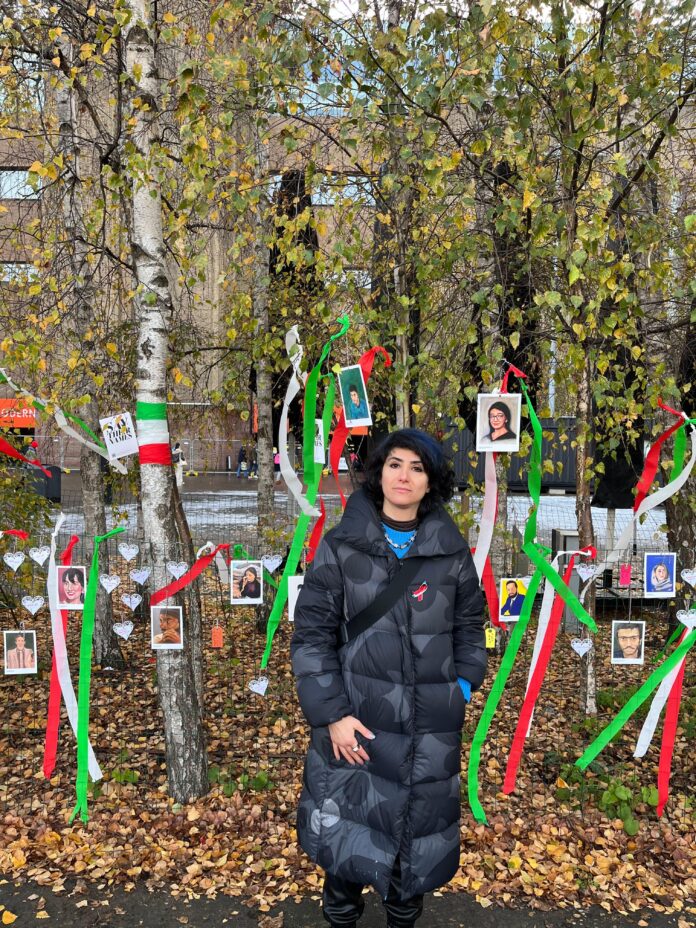From a distance there’s a festive Christmassy look to the red, white and green streamers fluttering in the riverside breeze in front of Tate Modern. But move closer and you see that these strips of crepe paper are interspersed with signs declaring ‘Say Their Names’ and multiple images of men, women and children. For red, white and green are also the colours of the Iranian flag, and the people whose faces and names are on display, tied to the fencing outside Tate Modern, are the 400-plus Iranians who have been killed by the regime since the protests erupted with the death of Mahsa Amini in September.
Say Their Names is an ongoing project instigated by the Iranian artist Anahita Rezvani-Rad, who has lived in London since 2004, when she couriered a Francis Bacon painting from Iran’s national collection to go on show at Tate Britain, and never went back.

Bill Woodrow and Richard Deacon, who have made two collaborative works, one of which commemorates the ten-year-old Kian Pirfalak
“My heart is burning—from the moment I wake my thoughts are consumed by what is happening in Iran,” Rezvani-Rad says. She explains that Say Their Names came from a desire to record and commemorate those who have died in the recent uprisings. These include a large number of children. “I wanted to archive them because there are so many, it’s a way to circulate their story and their images through artworks,” she adds. “Many of these killed have had their bodies buried late at night by the regime so their memorial does not turn into a protest. Their families have been under pressure to say they have died due to ‘natural causes’ so even in their death they cannot be honoured by their loved ones.”
Rezvani-Rad is making a painting a day depicting the victims of the current protests, and has also invited fellow artists to make memorial portraits of the deceased in a medium of their choice, which are then reproduced, laminated and put on display. These include Bill Woodrow and Richard Deacon, who have made two collaborative works, one commemorating the ten-year-old Kian Pirfalak, shot by gunmen in Izeh; and one in memory of Yalda Aghafazli, a 19-year-old protester who died after being released from Qarchak detention centre in Tehran, following a hunger strike and beatings. Both these portraits are accompanied by an image of a sculpted lion, in honour of the ritual of the Bakhtiari People to put a stone lion on the graves of eminent people from their tribe.

Trudi Warner’s tribute to Diana Mahmoudi
Among the other heart-rending images on show are Trudi Warner’s drawing of the cheeky grinning face of the nine year old Diana Mahmoudi, who was killed by Iranian forces in Piranshahr in October, and Michael Ajerman’s pastel drawing of the celebrity chef Mehrshad Shahidi Nejad, who was beaten to death by security forces on 26 October, one day before his 20th birthday.
For the time being, the display of faces and names can be seen outside Tate Modern, but this Wednesday (21 December), when both Brits and Iranians celebrate the longest night, Rezvani-Rad is also setting up the ‘Say Their Names’ memorial to Iran’s recent revolutionary heroes at Piccadilly Circus. Here, between 6-9pm, she and her fellow artists and Iranians—and anyone else who wants to join—will be lighting candles, sharing food and keeping these names alive.

Michael Ajerman in front of his work, commemorating the celebrity chef Mehrshad Shahidi Nejad, who was beaten to death by security forces on 26 October
Meanwhile Rezvani-Rad and her fellow countrymen and women are also inviting everyone to go onto the @saytheirnames_artproject Instagram page to learn more about how to remember these killed by the regime and to support the ongoing protests in Iran. If the Instagram page has vanished (Rezvani-Rad’s own account was suspended for a while) then the information is also available on this website.
In addition, they are calling on the British government to close the Iranian embassy and to freeze the assets of prominent Iranians in the UK. These include individuals such as Saied Reza Ameli, the secretary of Iran’s Supreme Council of Cultural Revolution, who, according to the Times is also a director of the London-based Islamic Human Rights Commission (IHRC), which is approved by the UK government to provide legal advice on Islamic dress codes and rules in schools. “Basically, we want the UK government to stop working with the Iranian Government in the same way as they are sanctioning Russia,” Rezvani-Rad says.

























